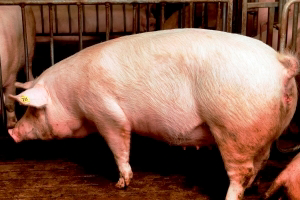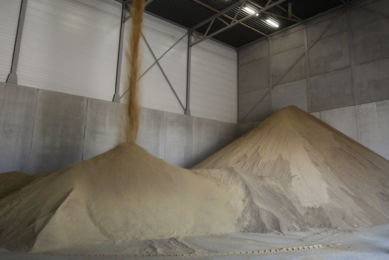Benefits of calcidiol for gilt reproduction

Vitamin D is a well-established nutrient. Yet, it is currently receiving renewed attention for newly discovered roles as an integral part of many systems ranging from immunity to reproduction, from muscle function to milk yield. In particular, vitamin D metabolite calcidiol plays a role in the selection rate of replacement gilts and their reproductive performance.
By Antoine Meuter, regional category manager vitamins, EMEA, DSM Nutritional Products, France (antoine.meuter@dsm.com)
The role of vitamin D in calcium and phosphorus metabolism is well known. Quite often, extra vitamin D supplementation is recommended for late-parity sows to reduce the rate of deterioration of the skeletal mass. At the other end of the scale, gilts are fundamental to sow-farm productivity and those raised in Europe must be prepared to the new group housing systems. Therefore this is essential to ensure an optimum frame development during the growing phase of the future breeders: The better the body and skeletal condition of the gilt at selection, the better the lifetime performance of a sow in a breeding herd.
Furthermore, first-parity sows and gilts in production usually suffer from general poor reproductive performance. This manifests in numbers of pigs born alive and weaned being markedly low compared to herd average. It is not unusual for first-parity sows to give birth to even two or three piglets less than the average number of later parity sows. And, this has been quite acceptable, at least until now. Naturally, one could not be faulted to think such animals as gilts and first-parity sows would benefit little from supplemental vitamin D; and with a good reason. These animals are young and following a correct rearing programme, they should have a strong and able skeletal system to support them through many parities. Yet, recent findings suggest that even these animals can benefit from supplemental vitamin D, or more correctly, from one of its major metabolites.
Vitamin D metabolites
There are two types of naturally occurring vitamin D. In plants, the predominant form is ergocalciferol (D2), while in animals, the predominant form is cholecalciferol (D3). It is important to mention here that vitamin D is a fat-soluble vitamin and as such it is absorbed along other lipids in the lymphatic system, a rather tedious process. It then reaches the liver where it must be converted (hydroxylated) to 25-OH-D3 (also called calcidiol). This hydroxylation makes vitamin D more able to circulate in the water-dominated environment of the blood system, and indeed, calcidiol is the main circulating form of the vitamin (Figure 1).
The functional form of vitamin D, however, is 1,25-(OH)2-D3 (also called calcitriol), which is even more water-friendly as it has a double degree of hydroxylation. This takes place in the kidneys using calcidiol as the stepping stone. This advanced metabolite is responsible for the regulation of calcium and phosphorus metabolism, and lately it has been implicated in a myriad other functions. It remains a widely unknown fact that vitamin D, or rather its metabolites, are in essence naturally occurring hormones. In fact, vitamin D metabolites, apart from their very significant role in calcium and phosphorus homeostasis, also control the expression of upwards 200 genes. This gives vitamin D a strong role in many functions. Only recently has the significant role of vitamin D metabolites on the proper function of the immune system been appreciated. Furthermore, the role of vitamin D metabolites on muscle functions is being actively investigated, with significant implications on meat quality technology.
Modern vitamin D
Hy-D is the commercial form of calcidiol, marketed by DSM Nutritional Products. Because calcidiol is less water phobic, it is absorbed more easily and quite differently from pure vitamin D3. In addition, as it is already one step ahead in the natural metabolism of vitamin D, it bypasses the first step of hydroxylation in the liver, reaching the blood stream quickly and very efficiently. It is currently believed that feeding calcidiol is the only way to increase blood levels of calcidiol as the liver acts as a barrier to hydroxylation of superfluous quantities of supplemental pure vitamin D.
Forthcoming research reports suggest that pigs supplemented with calcidiol have better overall calcium homeostasis compared to pigs fed with vitamin D3 leading to higher circulating levels calcidiol in plasma (Figure 2). For example, in sows, feeding 50 μg calcidiol per kg resulted not only in enhanced bone mass and longevity, but also in increased reproductive performance over many parities.
Research
Several studies have shown the calcidiol potential to increase the proportion of replacement gilts fit for breeding. For example, in a German trial run in cooperation with a genetic company, calcidiol supplementation improved gilt selection rate by 7% (Figure 3). Thanks to a positive effect on frame development, less gilts were refused due to failures on leg weaknesses. And this may have improved the sow longevity due to improvements in soundness and bone mineral concentration.
Research conducted by DSM Nutritional Products has also investigated the effects of feeding calcidiol, 50 μg/kg feed on the reproductive performance of breeding sows over five parities. The positive control sows were receiving 2,000 IU of pure vitamin D per kg feed over the same period. Feeding of each vitamin product was initiated when animals were six months old and continued until the end of the trial. The most surprising result (Table 1) was that first parity sows fed calcidiol had a higher number of pigs born alive, partly due to a lower number of mummified and stillborn piglets, but apparently also due to a higher conception rate and/ or lower embryonic mortality. In this research facility, average number of pigs born alive per litter does not exceed ten piglets, and for gilts actually farrowing 9.8 piglets alive is quite a feat, given the 7.6 piglets born to control sows, which were given a very generous level of pure vitamin D. Clearly, just increasing vitamin D is not sufficient to enhance reproductive performance, again indicating the restrictive role of the liver in regulating the blood levels of calcidiol. Thus, only by feeding the metabolite calcidiol, it is possible to bypass the liver barrier and provide the animal with greater levels of hormonal substrate, which leads to improved reproductive performance. Last but not least: The increased calcium and phosphorus status of first-parity sows fed calcidiol also led to better milk yields. This was shown in a heavier litter weight at weaning. Total litter weight for calcidiol fed sows was over 16 kg over control, while pre-weaning mortality was negligible in both groups. Calcidiol-fed first-parity sows not only matched the number of piglets born alive of their older counterparts in this farm, but they also managed to feed their piglets adequately.
Article featured in Pig Progress 29.1











